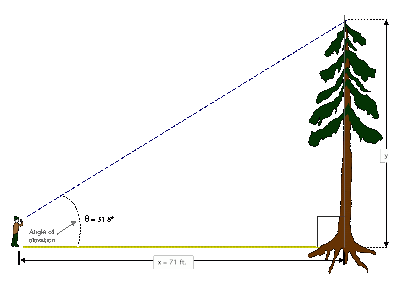How Tall Is That Tree?
How can you measure the
height of a tree? You can use several different math concepts to determine the
length of a tree without having to climb it tape measure in hand. We will go
over three methods you could use.
Method 1 uses
trigonometry, most notably the tangent function.
Method 2 uses similar
triangles and shadows
Method 1:
First you will need some method of measuring the angle of your line of sight. You could do this with a protractor or a sextant/clinometer if you happen to have one. After that stand far enough away from the tree so you can clearly see the top. Measure your distance from the tree and then using your tool of choice, measure the angle of your sight looking at the top of the tree. In the example below, the distance from the tree is 71 ft. and the angle is 31.8 degrees. You would then use the tangent (Opposite/Adjacent) of the angle multiplied times the distance from the tree. To get the height of the tree.
Method 2:
Measure
the tree’s shadow, and then measure your own shadow, or something like a
fence post you can measure. After you have those lengths, you can use proportions to solve for the height of the tree, because the ratio of your shadow to your self is the same as the ratio of the tree's shadow to its height. The example below shows a person who is 6 feet tall with a 5 feet shadow, and a tree with a 42 feet shadow.

